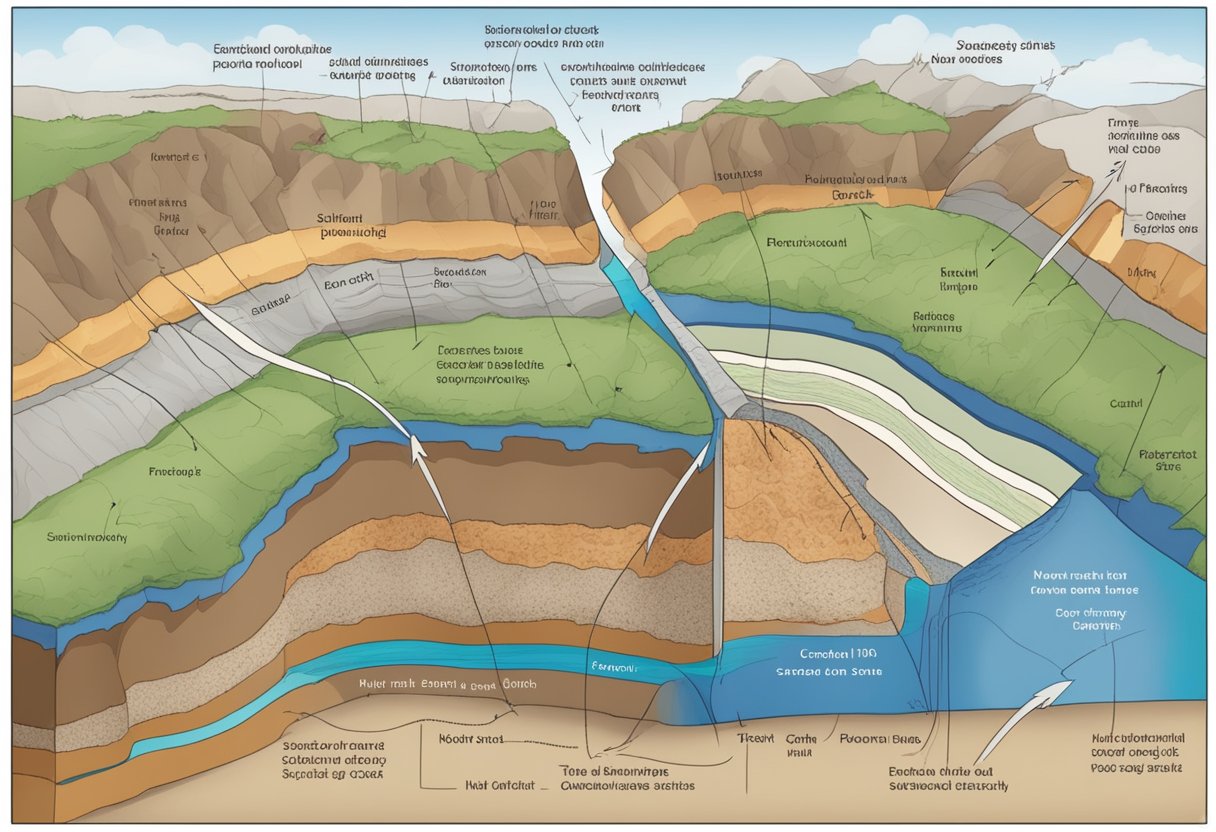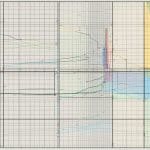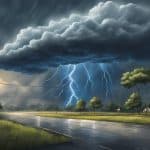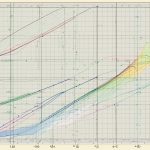Types Of Faults
Faults are fractures or zones of fractures between two blocks of rock that allow the blocks to move relative to each other. They are important geological features that can help in understanding the movement of the Earth’s crust. Faults can be classified based on their dip angle, slip direction, and slip rate. Understanding the different types of faults is crucial for earthquake hazard assessment, resource exploration, plate tectonics, and geological history.

The fundamentals of faults include the understanding of how they form and move. Faults are formed due to the movement of tectonic plates, which can result in compression, tension, or shear forces. The movement of these plates can cause rocks to break and form faults. Faults can move in different ways, including normal, reverse, strike-slip, and oblique-slip. The classification of faults is based on the direction of the movement of the rocks on either side of the fault plane.
In summary, understanding the different types of faults is crucial for geologists, seismologists, and other scientists who study the Earth’s crust. Faults can provide valuable information about the movement of tectonic plates and the history of the Earth’s geological processes. The following sections will provide a more detailed explanation of the different types of faults and their geological significance.
Key Takeaways
- Faults are fractures or zones of fractures between two blocks of rock that allow the blocks to move relative to each other.
- Faults can be classified based on their dip angle, slip direction, and slip rate.
- Understanding the different types of faults is crucial for earthquake hazard assessment, resource exploration, plate tectonics, and geological history.
Fundamentals of Faults
Definition and Characteristics
A fault is a fracture or a break in the Earth’s crust where rocks on either side of the fracture move relative to each other. Faults are formed due to the tectonic forces that act on the Earth’s crust. They are the result of the buildup of stress in the rocks, which eventually exceeds the strength of the rocks, leading to their rupture.
Faults can occur in any type of rock, but they are most common in the brittle rocks that make up the Earth’s crust. The characteristics of a fault depend on the type of rock and the type of stress that caused the fault. Faults can be classified based on their geometry, the type of movement, and the type of stress that caused the movement.
Components of a Fault
A fault consists of several components, including the fault plane, hanging wall, footwall, and fault zone. The fault plane is the surface along which the rocks have moved. The hanging wall is the block of rock that lies above the fault plane, while the footwall is the block of rock that lies below the fault plane. The fault zone is the region around the fault plane where the rocks have been deformed due to the movement of the fault.
The movement of the fault can be classified into three types: normal, reverse, and strike-slip. In a normal fault, the hanging wall moves down relative to the footwall, while in a reverse fault, the hanging wall moves up relative to the footwall. In a strike-slip fault, the rocks move horizontally past each other.
The deformation caused by the fault movement can be either elastic or plastic. In elastic deformation, the rocks return to their original shape once the stress is removed, while in plastic deformation, the rocks remain permanently deformed.
In conclusion, faults are an essential part of the Earth’s crust and play a crucial role in shaping the Earth’s surface. Understanding the components and types of faults is essential for geologists to study the tectonic forces that act on the Earth’s crust and predict earthquakes.
Classification of Faults
Faults are classified into three main categories based on the type of movement: dip-slip faults, strike-slip faults, and oblique-slip faults.
Dip-Slip Faults
Dip-slip faults are characterized by vertical movement along the fault plane. They are further classified into normal, reverse, and thrust faults. In normal faults, the hanging wall moves downward relative to the footwall. In reverse faults, the hanging wall moves upward relative to the footwall. Thrust faults are a type of reverse fault where the dip angle is shallow, and the hanging wall moves over the footwall.
Strike-Slip Faults
Strike-slip faults are characterized by horizontal movement along the fault plane. They are further classified into right-lateral and left-lateral faults, depending on the direction of movement. In right-lateral faults, the opposite side of the fault appears to move to the right when viewed from one side, while in left-lateral faults, the opposite side of the fault appears to move to the left.
Oblique-Slip Faults
Oblique-slip faults are characterized by a combination of vertical and horizontal movement along the fault plane. They are a combination of dip-slip and strike-slip faults. The amount of vertical and horizontal movement varies depending on the specific fault.
Overall, understanding the different types of faults and their classifications is crucial in understanding the Earth’s tectonic activity and the processes that shape our planet’s surface.
Fault Dynamics and Movement
Role of Tectonic Forces
Tectonic forces play a crucial role in the dynamics and movement of faults. These forces are generated by the movement of tectonic plates and can be compressional, tensional, or shear. Compressional forces push the rocks together, causing them to shorten and thicken, whereas tensional forces pull the rocks apart, causing them to thin and elongate. Shear forces cause the rocks to slide past each other in a horizontal direction.
Types of Stress and Strain
The movement of faults is a result of stress and strain in the rocks. Stress is the force acting on the rocks, while strain is the deformation caused by the stress. There are three types of stress: compression, extension, and shear. Compression occurs when rocks are pushed together, extension occurs when rocks are pulled apart, and shear occurs when rocks are pushed in opposite directions.
The sense of motion along a fault can be either normal or reverse, depending on the type of stress and strain. In a normal fault, the hanging wall moves downward relative to the footwall, while in a reverse fault, the hanging wall moves upward relative to the footwall. Strike-slip faults are characterized by horizontal movement, with minimal vertical displacement.
Friction plays a significant role in the movement of faults. When the rocks are under stress, friction prevents the rocks from sliding past each other. However, when the stress exceeds the frictional strength of the rocks, the rocks will slide past each other, causing an earthquake.
In summary, the movement of faults is a result of tectonic forces, stress, and strain. The type of stress and strain determines the sense of motion along a fault, while friction plays a crucial role in preventing or causing the movement of rocks.
Geological Significance of Faults
Faults are important geological features that play a crucial role in the formation of the Earth’s crust. They are the result of tectonic activity and are responsible for the movement of large sections of the Earth’s crust. Faults can be found all over the world and are responsible for some of the most significant geological events in history.
Faults and Earthquakes
One of the most significant geological events associated with faults is earthquakes. Earthquakes occur when there is a sudden release of energy due to the movement of rock along a fault. The San Andreas Fault in California is one of the most well-known examples of a fault that has caused significant seismic events. The movement of the Pacific Plate and the North American Plate along the San Andreas Fault has caused numerous earthquakes, including the 1906 San Francisco earthquake.
Seismic waves generated by earthquakes can cause significant damage to buildings and infrastructure. Understanding the location and movement of faults is crucial in predicting and mitigating the effects of earthquakes.
Faults and Mountain Building
Faults are also responsible for the formation of mountain ranges. When two tectonic plates collide, the pressure and friction can cause the rocks to fold and uplift, forming mountain ranges. The Rocky Mountains in North America are an example of a mountain range that was formed due to tectonic activity and faulting.
Faults can also cause the formation of fault scarps, which are steep cliffs that are formed along the fault line. These fault scarps can be used to determine the amount of displacement that has occurred along the fault.
Understanding the geological history of a region and the movement of faults is essential in predicting the potential for seismic events and mountain building. By studying fault offset and seismic events, geologists can gain insight into the tectonic activity that has occurred in a region and make predictions about future seismic events.
Global Fault Systems
Major Faults Around the World
There are several major faults that can be found around the world. One of the most famous is the San Andreas Fault in California, USA. This fault is a transform fault, which means that it is caused by the movement of two tectonic plates sliding past each other. The San Andreas Fault is responsible for many earthquakes in California, including the 1906 San Francisco earthquake.
Another significant fault is the Anatolian Fault, which runs through Turkey. This fault is a transform fault that forms the boundary between the Anatolian Plate and the Eurasian Plate. The Anatolian Fault is responsible for many earthquakes in Turkey, including the 1999 Izmit earthquake.
Faults and Plate Boundaries
Faults are often found at plate boundaries, which are the places where tectonic plates meet. There are three types of plate boundaries: convergent, divergent, and transform. Convergent plate boundaries occur when two plates collide, and one plate is forced under the other in a process called subduction. Divergent plate boundaries occur when two plates move away from each other, and new crust is formed in the gap. Transform plate boundaries occur when two plates slide past each other.
Subduction zones are also a type of plate boundary. These are areas where one tectonic plate is forced under another plate. Subduction zones are responsible for some of the world’s largest earthquakes, including the 2011 Tohoku earthquake in Japan.
The North American Plate is a tectonic plate that covers most of North America. It is bounded by several major faults, including the San Andreas Fault and the New Madrid Fault. The North American Plate is also responsible for the formation of the Rocky Mountains.
Overall, faults and plate boundaries play a crucial role in the movement and shaping of the Earth’s crust. Understanding these geological processes is essential for predicting and preparing for earthquakes and other natural disasters.






